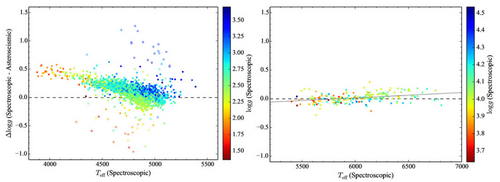Calibration of LAMOST Stellar Surface Gravites Using the KEPLER Asteroseismic Data
Researchers from the National Astronomical Observatories, Chinese Academy of Science (NAOC) have determined precise stellar fundamental parameters by combining the medium-resolution spectra from LAMOST and the asteroseismology parameters determined from the NASA Kepler telescope. By comparing the stellar surface gravities (logg) from these two different datasets, calibration relations have been established, which is important for distance determinations using LAMOST spectra.
Stellar surface gravity (logg) is one of the most important fundamental parameters in stellar physics. However, logg from low- to medium-resolution spectra are not satisfied compared with other ones. Recent progresses made by the NASA Kepler satellite have revolutionized in many fields of astronomy. By taking the advantages of accurate stellar oscillation data from Kepler, the researchers consistently derived stellar parameters for a large sample of stars, along with the Teff and [Fe/H] values from the LAMOST spectra. The entire sample contains 2831 giants and 229 dwarfs, of which 15 have been confirmed to harbor extra-solar planets and 22 are potential planet-host candidates. Clear trends can be found between the differences of spectroscopic and seismic logg, and the effective temperatures from LAMOST spectra. Calibration relations for both dwarfs and giants have been established, according to which the systematic offsets of up to 58% on radius and distance of giants can be corrected. The work also shows the risk of stellar mass determining without using spectroscopic parameters in extra-solar planet studies, and the advantage of combining the oscillation data and spectroscopic parameters.
This research article has been published on The Astronomical Journal, 152:6 (14pp), 2016 July.

Figure: Differences of spectroscopic logg and asteroseismic logg, as functions of effective temperatures for giants (left) and dwarfs (right). The colors are coded with their logg.